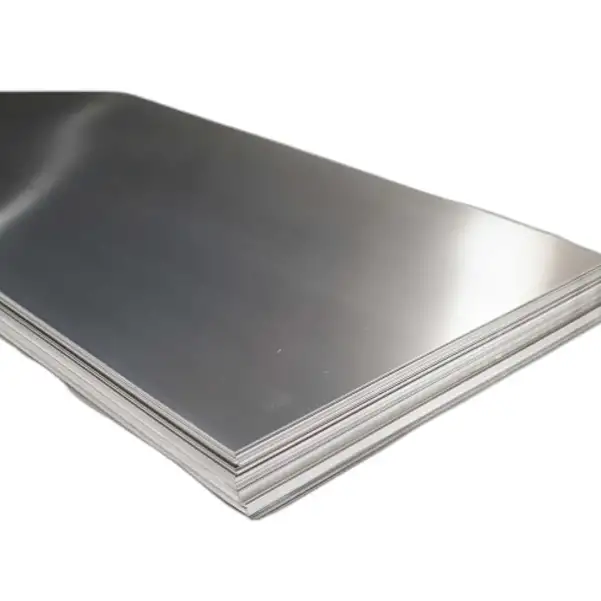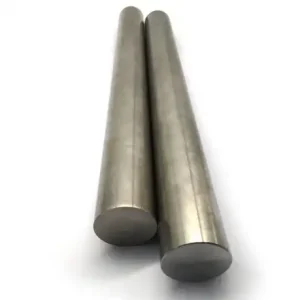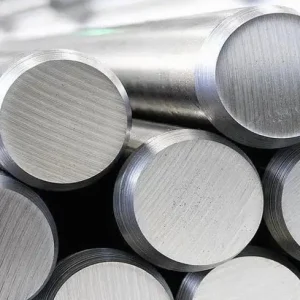304H stainless steel plate represents one of the most reliable high-temperature austenitic materials in modern industrial applications. This specialized variant of the standard 304 grade offers enhanced creep resistance and superior performance in elevated temperature environments, making it an essential component for power generation, petrochemical processing, and high-temperature structural applications.
What is 304H Stainless Steel?
304H stainless steel is a modified version of the widely-used 304 austenitic stainlless steel, specifically engineered for high-temperature service applications. The "H" designation indicates higher carbon content compared to standard 304, which significantly improves its creep strength and resistance to deformation under prolonged exposure to elevated temperatures.
We classify 304H as an austenitic chromium-nickel stainless steel that maintains its structural integrity at temperatures ranging from 425°C to 816°C (800°F to 1500°F). This material exhibits excellent corrosion resistance, superior weldability, and remarkable ductility even under extreme thermal conditions.
The development of 304H was driven by the nuclear power industry's need for materials capable of withstanding prolonged high-temperature exposure without significant dimensional changes. Its unique metallurgical properties make it particularly suitable for applications where thermal cycling and sustained loading occur simultaneously.
Chemical Composition of 304H Stainless Steel
The chemical composition of 304H stainless steel is carefully controlled to optimize high-temperature performance while maintaining corrosion resistance characteristics.
| Element | Composition (%) | Function |
|---|---|---|
| Carbon (C) | 0.04-0.10 | Enhances high-temperature strength and creep resistance |
| Chromium (Cr) | 18.0-20.0 | Provides corrosion resistance and oxidation protection |
| Nickel (Ni) | 8.0-10.5 | Maintains austenitic structure and improves toughness |
| Manganese (Mn) | ≤2.0 | Aids in deoxidation and improves hot workability |
| Silicon (Si) | ≤0.75 | Acts as deoxidizer and improves high-temperature properties |
| Phosphorus (P) | ≤0.045 | Controlled to prevent hot cracking |
| Sulfur (S) | ≤0.030 | Minimized to maintain corrosion resistance |
| Iron (Fe) | Balance | Base metal providing structural foundation |
The elevated carbon content distinguishes 304H from standard 304, enabling formation of chromium carbides that strengthen grain boundaries at high temperatures. This controlled chemistry ensures optimal performance in demanding thermal environments.
Mechanical Properties of 304H Stainless Steel
304H exhibits exceptional mechanical properties that make it suitable for high-stress, high-temperature applications across various industries.
| Property | Value | Test Condition |
|---|---|---|
| Tensile Strength | 515 MPa (75 ksi) minimum | Room temperature |
| Yield Strength (0.2% offset) | 205 MPa (30 ksi) minimum | Room temperature |
| Elongation | 40% minimum | 50mm gauge length |
| Hardness | 201 HB maximum | Brinell scale |
| Modulus of Elasticity | 200 GPa (29×10⁶ psi) | Room temperature |
| Thermal Expansion | 17.3 μm/m°C | 20-100°C |
| Thermal Conductivity | 16.2 W/m·K | 100°C |
| Electrical Resistivity | 0.72 μΩ·m | 20°C |
| Density | 8.0 g/cm³ | Room temperature |
These properties remain stable across a wide temperature range, with the material retaining significant strength even at elevated temperatures where standard austenitic grades begin to lose structural integrity.
Specifications of 304H Stainless Steel Plate
304H stainless steel plates are manufactured according to strict specifications that ensure consistent quality and performance in critical applications.
| Specification | Standard | Thickness Range | Width Range | Length Range |
|---|---|---|---|---|
| ASTM A240/A240M | Type 304H | 3mm - 100mm | 1000mm - 2500mm | 2000mm - 6000mm |
| ASME SA-240 | Grade 304H | 1/8" - 4" | 36" - 96" | 96" - 240" |
| EN 10088-2 | 1.4948 | 2mm - 80mm | 1000mm - 2000mm | 2000mm - 4000mm |
| JIS G4304 | SUS304H | 3mm - 75mm | 914mm - 1829mm | 1829mm - 3658mm |
| GB/T 4237 | 022Cr19Ni10 | 3mm - 60mm | 1000mm - 2000mm | 2000mm - 6000mm |
Manufacturing tolerances follow strict dimensional requirements, with thickness tolerance typically ±0.1mm for plates under 10mm and ±3% for thicker sections. Surface finish options include 2B, BA, No.1, and custom finishes depending on application requirements.
Standards for 304H Stainless Steel
304H stainless steel conforms to multiple international standards, ensuring global acceptance and consistent quality across different markets. ASTM A240 serves as the primary specification in North American markets, while EN 10088 governs European applications.
The ASME Boiler and Pressure Vessel Code specifically recognizes 304H for high-temperature service, with allowable stress values defined for temperatures up to 816°C. Nuclear applications follow additional standards including ASTM A240 with supplementary requirements and ASME Section III specifications.
Quality control measures include chemical analysis verification, mechanical testing at room and elevated temperatures, and non-destructive testing methods such as ultrasonic inspection and magnetic particle testing where applicable.
Equivalent Grades of 304H Stainless Steel
Understanding equivalent grades across different international standards ensures proper material selection and procurement flexibility.
| Standard | Grade Designation | Country/Region |
|---|---|---|
| ASTM | 304H | United States |
| AISI | 304H | United States |
| EN | 1.4948 | Europe |
| JIS | SUS304H | Japan |
| GB | 022Cr19Ni10 | China |
| DIN | X6CrNi18-10 | Germany |
| BS | 304S51 | United Kingdom |
| AFNOR | Z6CN18-09 | France |
| UNI | X6CrNi18-10 | Italy |
These equivalents maintain similar chemical compositions and mechanical properties, though minor variations may exist due to regional specification requirements. Always verify specific requirements with relevant standards when substituting grades.
Difference Between 304 and 304H Stainless Steel
The primary distinctions between 304 and 304H stainless steel relate to carbon content and intended service temperatures.
| Property | 304 Standard | 304H High Temperature | Impact |
|---|---|---|---|
| Carbon Content | 0.08% maximum | 0.04-0.10% | 304H has controlled minimum carbon |
| Service Temperature | Up to 425°C | Up to 816°C | 304H suitable for higher temperatures |
| Creep Resistance | Limited | Excellent | 304H resists deformation under load |
| Carbide Precipitation | Possible sensitization | Controlled carbide formation | 304H maintains corrosion resistance |
| Applications | General purpose | High-temperature service | 304H for power generation, petrochemicals |
| Cost | Standard pricing | Premium pricing | 304H commands higher market price |
The controlled carbon range in 304H prevents both excessive carbide formation and inadequate high-temperature strength, optimizing performance for sustained elevated temperature operation.
Applications of 304H Stainless Steel Plate
304H stainless steel plates serve critical functions across industries requiring reliable high-temperature performance and corrosion resistance.
Power generation facilities utilize 304H for superheater tubes, steam generator components, and reactor internals where temperatures exceed standard grade capabilities. The material's creep resistance prevents dimensional changes during prolonged operation cycles.
Petrochemical refineries employ 304H in heat exchangers, furnace tubes, and reactor vessels processing corrosive media at elevated temperatures. Its dual resistance to both corrosion and thermal stress makes it invaluable for complex chemical processes.
Food processing equipment manufacturers specify 304H for high-temperature sterilization systems, pasteurization equipment, and commercial cooking appliances where thermal cycling occurs regularly.
Nuclear power plants rely on 304H for reactor pressure vessel internals, steam generator tubing, and other components exposed to both radiation and high temperatures throughout extended operating periods.
Classification of 304H Stainless Steel Plate
304H stainless steel plates are classified according to various criteria including manufacturing method, surface condition, and dimensional characteristics.
| Classification Type | Categories | Characteristics |
|---|---|---|
| Manufacturing Method | Hot Rolled, Cold Rolled | Hot rolled for thick sections, cold rolled for precision |
| Surface Finish | 2B, BA, No.1, No.4 | Different surface textures for specific applications |
| Edge Condition | Mill Edge, Slit Edge, Cut Edge | Determines final processing requirements |
| Dimensional Tolerance | Standard, Precision | Precision grades for critical applications |
| Flatness | Commercial, Precision Flat | Precision flat for machining applications |
| Testing Level | Standard, Enhanced | Enhanced testing for critical applications |
| Certification | Mill Test Certificate, 3.1 Certificate | Documentation level for traceability |
Each classification serves specific application requirements, with selection based on final use conditions and performance criteria.
Global Market Pricing for 304H Stainless Steel Plate (2025)
Current market conditions reflect complex supply chain dynamics affecting 304H stainless steel plate pricing across major global markets.
| Region | Price Range (USD/MT) | Market Factors | Supply Status |
|---|---|---|---|
| North America | $3,200 - $3,800 | Strong industrial demand, energy sector recovery | Adequate supply |
| Europe | $3,100 - $3,600 | Green energy infrastructure projects | Tight supply |
| Asia-Pacific | $2,800 - $3,400 | Manufacturing expansion, infrastructure development | Variable supply |
| China | $2,600 - $3,200 | Domestic capacity expansion, export competition | Oversupply |
| India | $2,900 - $3,500 | Growing industrial base, infrastructure needs | Moderate supply |
| Middle East | $3,000 - $3,700 | Oil & gas sector investment, power projects | Import dependent |
| South America | $3,100 - $3,800 | Mining sector demand, infrastructure projects | Limited supply |
Pricing fluctuations result from raw material costs, energy prices, transportation expenses, and regional demand patterns. Long-term contracts often provide more stable pricing compared to spot market transactions.
304H Stainless Steel Plate Sizes and Weight Parameters
Understanding dimensional specifications and weight calculations is essential for proper material planning and structural design.
| Thickness (mm) | Weight (kg/m²) | Common Widths (mm) | Standard Lengths (mm) | Typical Applications |
|---|---|---|---|---|
| 3 | 24.0 | 1000, 1219, 1500 | 2000, 2438, 3000 | Light structural, cladding |
| 5 | 40.0 | 1000, 1219, 1500 | 2000, 2438, 3000 | Moderate load applications |
| 8 | 64.0 | 1000, 1219, 1500, 2000 | 2000, 2438, 3000, 6000 | Pressure vessels, tanks |
| 10 | 80.0 | 1000, 1219, 1500, 2000 | 2000, 2438, 3000, 6000 | Heavy structural components |
| 15 | 120.0 | 1000, 1500, 2000 | 2000, 3000, 6000 | Thick-walled pressure vessels |
| 20 | 160.0 | 1000, 1500, 2000 | 2000, 3000, 6000 | Heavy industrial equipment |
| 25 | 200.0 | 1500, 2000 | 2000, 3000, 6000 | Specialized heavy applications |
| 30 | 240.0 | 1500, 2000 | 2000, 3000, 6000 | Extreme service conditions |
Weight calculations use density of 8.0 g/cm³, with actual weights varying slightly based on chemical composition and processing conditions.
Advantages of 304H Stainless Steel Plate
304H stainless steel plate offers multiple advantages that justify its selection for demanding high-temperature applications.
Superior creep resistance prevents dimensional instability under prolonged loading at elevated temperatures, maintaining structural integrity throughout extended service periods. This characteristic proves invaluable in power generation and petrochemical applications where thermal cycling occurs regularly.
Excellent corrosion resistance in various environments ensures long-term durability and reduces maintenance requirements. The chromium-nickel chemistry provides protection against oxidation, scaling, and many corrosive media encountered in industrial processes.
Outstanding weldability allows for complex fabrication without compromising material properties. Proper welding procedures maintain the high-temperature performance characteristics while preserving corrosion resistance at weld zones.
Proven nuclear service qualification demonstrates the material's reliability under the most demanding conditions. Extensive testing and operational history provide confidence for critical applications requiring absolute dependability.
Cost-effectiveness results from extended service life, reduced maintenance intervals, and reliable performance that minimizes unplanned shutdowns. Initial premium costs are offset by superior lifecycle economics.
Manufacturing Process of 304H Stainless Steel Plate
The manufacturing process for 304H stainless steel plate involves precise control at each stage to ensure consistent quality and performance characteristics.
Electric arc furnace melting begins the process, where carefully measured raw materials including recycled stainless steel, chromium, nickel, and other alloying elements are melted under controlled atmospheric conditions. Temperature control and chemical analysis during melting ensure proper composition.
Argon oxygen decarburization refining follows primary melting, removing excess carbon and adjusting final chemistry to meet 304H specifications. This step proves critical for achieving the precise carbon range required for high-temperature performance.
Continuous casting produces steel slabs with controlled cooling rates that prevent segregation and ensure uniform microstructure. Slab thickness and cooling parameters are optimized for subsequent hot rolling operations.
Hot rolling reduces slab thickness to intermediate gauge while maintaining proper temperature control to prevent grain growth and ensure uniform mechanical properties. Multiple passes achieve final thickness with controlled reduction ratios.
Solution heat treatment at approximately 1050°C dissolves chromium carbides and homogenizes the microstructure. Rapid cooling preserves the austenitic structure and prevents sensitization that could compromise corrosion resistance.
Surface conditioning removes scale and prepares the surface for final inspection. Pickling and passivation restore corrosion resistance and provide the specified surface finish.
Quality control testing verifies chemical composition, mechanical properties, dimensional accuracy, and surface condition before shipment. Each plate receives individual certification documenting compliance with specifications.
Case Study: Iraqi Power Plant Project
A recent project in Iraq demonstrates the successful application of 304H stainless steel plate in challenging operating conditions. The 500MW thermal power plant required materials capable of withstanding both high temperatures and the corrosive environment typical of Middle Eastern industrial facilities.
We supplied 850 tonnes of 304H stainless steel plate in various thicknesses ranging from 8mm to 25mm for superheater construction and steam generator components. The plates were manufactured to ASTM A240 standards with additional testing requirements specified by the end user.
Environmental challenges included ambient temperatures exceeding 50°C, high humidity levels, and the presence of sulfur compounds in the local atmosphere. Standard 304 grade materials had previously experienced premature failure due to insufficient creep resistance and accelerated corrosion under these conditions.
Technical specifications required plates with enhanced mechanical properties, including minimum tensile strength of 550 MPa and elongation exceeding 45%. Special surface preparation was implemented to ensure optimal performance in the aggressive operating environment.
Installation proceeded smoothly with no welding difficulties encountered during fabrication. The controlled carbon content of 304H provided excellent weldability while maintaining high-temperature strength characteristics essential for reliable operation.
Performance monitoring over 18 months of operation confirms that the 304H material is meeting all design requirements. No signs of creep deformation, corrosion, or other degradation have been observed, validating the material selection for this demanding application.
Economic benefits include extended maintenance intervals, improved plant availability, and reduced lifecycle costs compared to previously used materials. The success of this project has led to specification of 304H for additional power generation projects in the region.
Frequently Asked Questions
Q1: What is the maximum service temperature for 304H stainless steel plate?
304H stainless steel plate can safely operate at temperatures up to 816°C (1500°F) under ASME Boiler and Pressure Vessel Code allowable stress conditions. For intermittent service, short-term exposure to higher temperatures may be acceptable depending on specific application requirements and stress levels.
Q2: Can 304H stainless steel be welded without affecting its high-temperature properties?
Yes, 304H can be successfully welded using standard austenitic stainless steel procedures. The controlled carbon content actually improves weldability compared to some other high-temperature grades. Post-weld heat treatment is typically not required, though stress relief may be beneficial for thick sections or complex geometries.
Q3: How does the corrosion resistance of 304H compare to standard 304?
304H maintains similar corrosion resistance to standard 304 in most environments. The slightly higher carbon content does not significantly impact general corrosion resistance, though care must be taken to avoid sensitization temperature ranges during prolonged heating cycles.
Q4: What testing is required to verify 304H quality for high-temperature applications?
Standard testing includes chemical analysis, room temperature tensile testing, and hardness measurement. For high-temperature service, creep testing may be required along with elevated temperature tensile tests. Non-destructive testing such as ultrasonic inspection is commonly specified for pressure boundary applications.
Q5: Is 304H suitable for nuclear power plant applications?
304H is widely used in nuclear power plants for non-reactor pressure vessel applications including steam generators, pressurizers, and piping systems. For reactor pressure vessel internals, additional requirements per ASTM A240 with nuclear supplements may apply.
Q6: What surface finishes are available for 304H stainless steel plates?
Standard surface finishes include 2B (cold rolled, annealed and pickled), BA (bright annealed), No.1 (hot rolled, annealed and pickled), and various polished finishes. Selection depends on application requirements for appearance, cleanability, and corrosion resistance.
Q7: How should 304H stainless steel plates be stored to prevent contamination?
Plates should be stored in clean, dry conditions with adequate ventilation. Avoid contact with carbon steel or other materials that could cause contamination. Use wooden or plastic separators between plates and protect surfaces from physical damage during handling.
Q8: What factors affect the pricing of 304H stainless steel plate?
Primary cost drivers include raw material prices (especially nickel and chromium), energy costs, transportation expenses, and market demand. The premium over standard 304 reflects the tighter chemistry control and enhanced testing requirements for high-temperature service qualification.
Authoritative References
- ASTM A240/A240M - Standard Specification for Chromium and Chromium-Nickel Stainless Steel Plate, Sheet, and Strip
- ASME Boiler and Pressure Vessel Code, Section II - Materials
- EN 10088-2 - Stainless Steels - Technical Delivery Conditions for Sheet/Plate and Strip
- ISO 15510 - Stainless Steels - Chemical Composition





